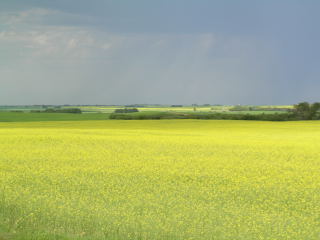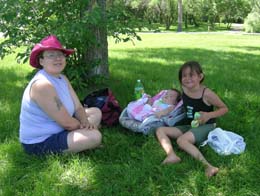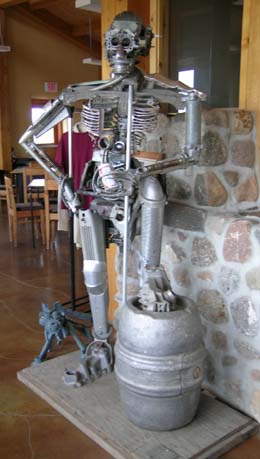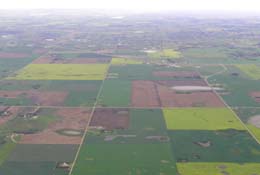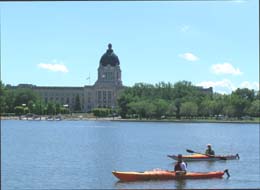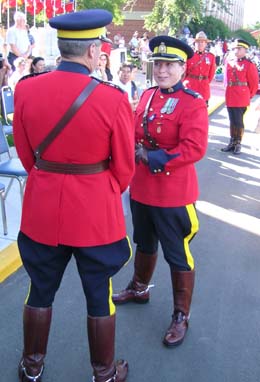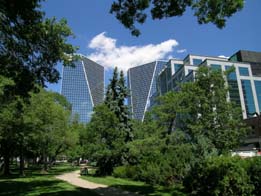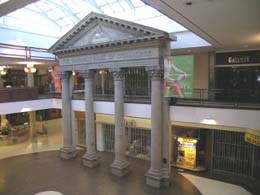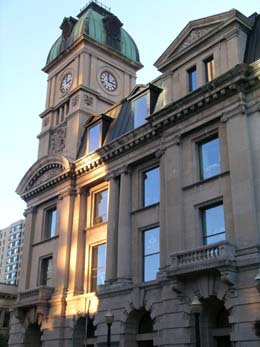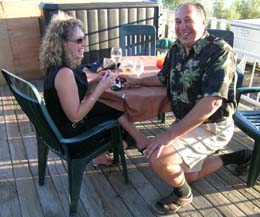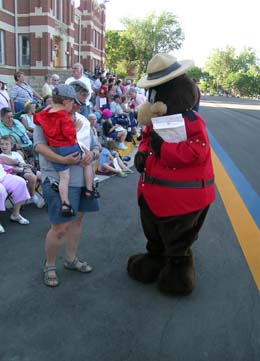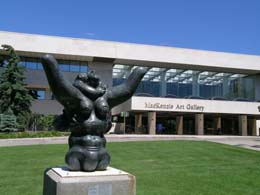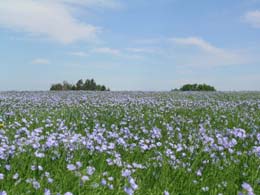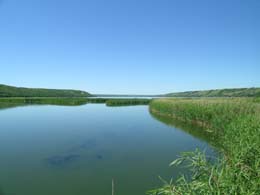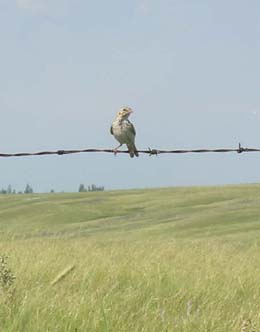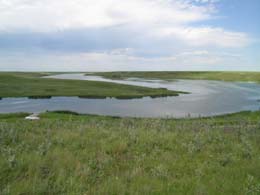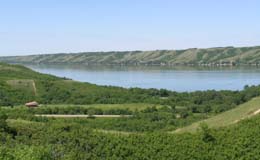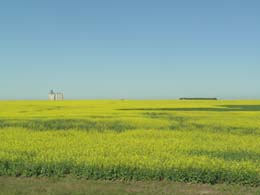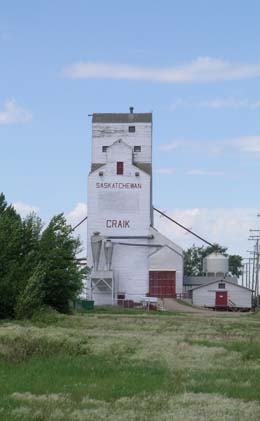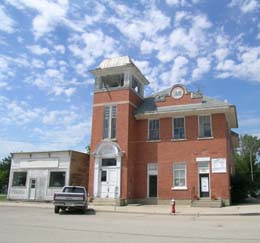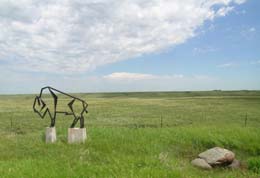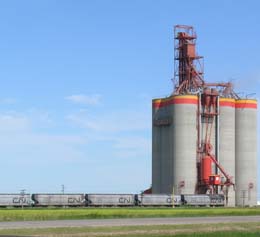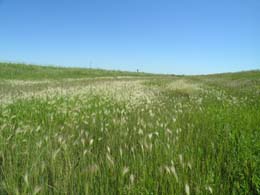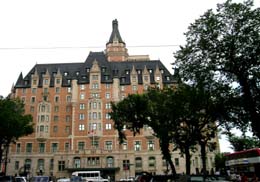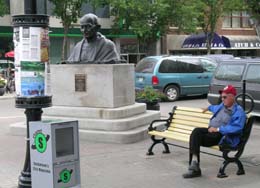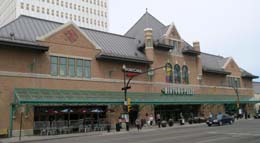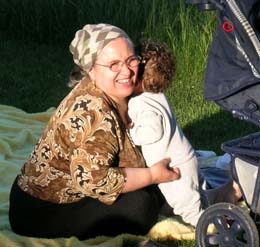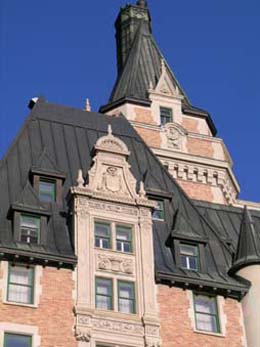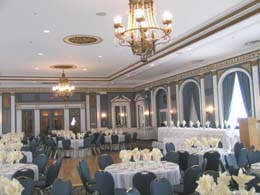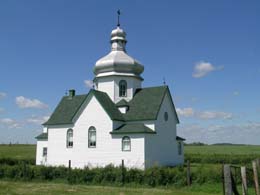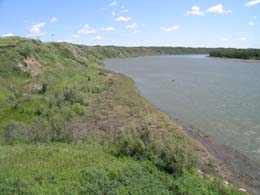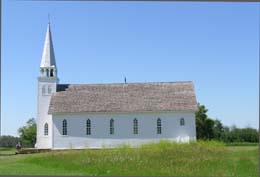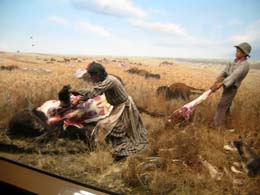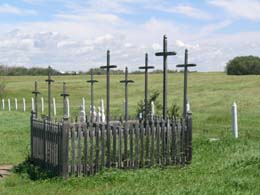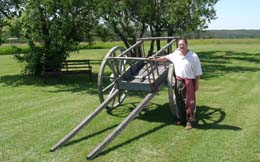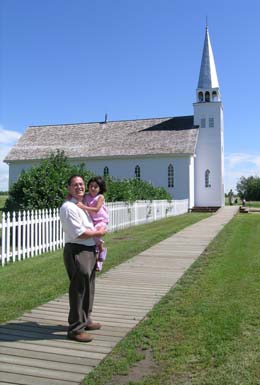|
|
Saskatchewan:
“As far as the eye can see” is one of the most apt descriptors for Saskatchewan. However it is also through the mind's eye that you absorb the full and personal perspective of this rich landscape. This is a prairie outlook; it liberates by integrating a unique topographical space with a private sense of space. Saskatchewan engages visitors in such a way that they experience a transcendance of time and space. |
||
Spatial sense and sensibility The heart and soul of this spectacular part of Canada is omnipresent in the land; in the people, their values, their traditions, and their interdependent relationship with the prairie. The relationship is one of cooperation and collaboration — in the best of times and the worst of times — and is the embodiment of common sense, interconnectedness, and empathy. And these communal traits flow from a keen mindfulness of land and landscape.
As my Air Canada flight from Toronto takes me from east to west, I look down on the geographical context in which the course of history was played out in this vast land called Canada. We pass over the Great Lakes, part of the most extensive inland waterway on the planet, and then over the remnants of old and craggy mountains we call the Canadian Shield. But soon the aircraft enters a new kind of space as it drifts over flat prairie land, an indefinite and unending terrain. The early summer patchwork prairie is luxuriant; it has been a wet spring and the greens, golds, and rich earth tones of the land seem to extend forever, disappearing into a misty horizon. There is a softness to the prairie; a promise of ease, abundance, and a gentle welcome. The Queen City Regina, the capital of the province of Saskatchewan, gets my vote for most contextual and most successfully integrated urban setting and design. This very lovely city, named after Queen Victoria (the “Grandmother of Europe”), is also a good example of what, for me, becomes a constant theme in Saskatchewan: anticipate everything; be surprised by nothing. And this theme works in concert with Saskatchewan's motto “From many peoples strength.” Founded in 1882 as an offshoot of the building of Canada's transcontinental railway (the “National Dream” that completed the uniting of this country from east to west), Regina is today a lovely contemporary city that is a shady oasis on the prairie. It is very much an urban environment that manages to be the best of both worlds. Its shady streets are made so because of the non-indigenous trees that have been transplanted to the prairie — over 350,000 and each hand-planted over many generations. And like its central Market Square and downtown business area, Regina is a city that creates a cohesive and integrated municipality but one that also blends into the prairie milieu. When the railway determined that Regina should be built on the banks of the Wascana Creek (also known as the Pile O' Bones Creek), the town became a focal point for westward expansion and as a key access point to Canada's prairie “breadbasket.” Surrounded by the great wheat-growing plains (almost 20 million acres in the province), Regina became the headquarters for the Saskatchewan Wheat Pool and also was chosen as the headquarters of the North-West Mounted Police who would eventually be known as the Royal Canadian Mounted Police. It is also today a major stopping point on “Canada's Main Street” — the Trans-Canada Highway, which in many ways parallels the mandate of the railway, both of which have direct links to the original First Nations and fur-trading routes across this vast area of Western Canada. Like most communities in Saskatchewan that I visited, there is in Regina a geographical integrity that underscores the beauty and the openness of the prairie. Regina is especially noted for Wascana Centre, an enormous green space of over 2000 acres in the centre of the city that surrounds the serene man-made Lake Wascana. Referred to as the “crown jewel of the Queen City,” Wascana Lake was constructed in 1897 and has recently undergone a revitalization program that is in itself a model of environmental integrity. And Wascana Centre is the kind of green urban space that reflects and enhances the fertility of the prairie lands that in turn surround the city. Wascana Centre is also a web of vital human spaces and amenities: parks, hiking paths, art galleries, museums, restaurants, and quiet, shady neighbourhoods of elegant homes. Regina is a model of town planning in the way in which it blends cityscape and landscape. Personal recommendations:
The Qu'Appelle Valley: Who Calls? If you drive northeast from Regina on Highway 10, and this is your first visit to Saskatchewan, you will start to get your first up close and personal view of prairie land. If it is spring, you will see immense fields of brilliant gold canola, every shade of green in nature's palette, and soft lavender fields of flax. And all of this will be punctuated by the deep blue of sloughs (pronounced slews) here and there; natural and man-made shallow bodies of water that store the winter run-off and spring rains to irrigate the prairie so that by summer's end the land will produce the golden waving wheat fields we are accustomed to seeing as quintessential Saskatchewan. The sky will be the kind of intense blue that is rarely seen anymore in smog-bound urban centres. Imagine now the last continental glacier of the Quaternary period that dragged itself across the land as it retreated to the north, transforming the land, leaving rich sediment that is the fundament of the Great Plains and their grasslands; shallow lakes; and a 267-mile long trench that traverses the southern part of the province. And as you approach this singular geological interruption in the prairie landscape, you will meet for the first time the Qu'Appelle River Valley where it widens and gives birth to a series of tranquil lakes. You will also start to see the undulating hills that were also forged by the glacier. The Qu'Appelle Valley accentuates the interplay of geology, culture, history, agriculture, and recreation. In this exceptional natural setting, you can imagine the time before the incursion of the European newcomers when boundless herds of bison moved across the land followed by aboriginal people who lived beside them — and from them. During a spring visit, you will also see the prairie and the hills abloom with wildflowers. If you are a birder, you will be in your element. And time may just stand still a little for you so that you can re-acclimatize your senses to a prairie reality.
And sitting in your own little prairie space by the edge of one of these modest lakes, you might, as I did, read passages from Trevor Herriot's book, pause, look around, and just let the cognitive side of your brain go on hold. You may also read about the romantic Cree legend that gave it's name to the Valley. You may also get a visit from a songbird, or other prairie residents. In the Qu'Appelle Valley you will also start to appreciate the grasslands-based culture of First Nations and Métis people, the personal sense of privacy that this type of interconnected time-space permits, and why the opening of new frontiers can be a mixed blessing. In a park beside a sandy beach, I talk with Memory Pelletier, who lives on a reserve in the Qu'Appelle Valley (also known as “the oasis of the Prairies”) with her husband and three children. Memory is both of First Nations and Métis heritage and is also a recent graduate in radio and television arts.
The Louis Riel Trail In her interview, Memory mentions that “everyone has heard about him” (Louis Riel), and for Canadians it is true that the name resonates deeply, even though the details of this man's life may remain sketchy. “Louis Riel” does however evoke events, imagery, and historical concepts that are part of the collective Canadian psyche. And even though most Canadians (yours truly included) are generally aware of the significance of his role in a critical and enduring moment in Canadian history, the layers of understanding that such history merits begin to unveil themselves when you visit the land and landscapes that were integral to that history. And so I head north from Regina on Highway 11 (the Louis Riel Trail) sensing that I will eventually experience a part of Saskatchewan that cannot be known in the abstract alone. And although my journey has a bit of a hiatus here — interconnectedness is as fluid and current a theme in Saskatchewan history as is the Qu'Appelle River and Valley that I will encounter several more times en route — I will encounter the full reality of Riel later on the land where he fought for the rights of his people. The road is picture postcard perfect, and Saskatchewan as I have always envisioned it. There are many moments when I see in front of me a band of asphalt that plays the optical trick of narrowing and disappearing into itself, merging with the horizon. Straight lines are illusory. The sometimes totally flat, sometimes gently rolling land on either side of the road seems to act like buffers that gently apply pressure to the road giving it momentum but not a sense of urgency. Arrival is inevitable; even visible — although a long way off. Saskatchewan has the longest roads per capita in Canada and the distances they cover teach patience and introspection. I am now definitely in “as far as the eye can see” country and visualize First Nations people moving slowly and deliberately across the land, or Métis people in their Red River carts. Highway 11 is a no nonsense road that will get you from here to there in good time, and in a pragmatic and imperturbable fashion. But it is also the kind of highway that goes somewhere, in a deeper sense. The road is also a non stop photo op, but I do stop, frequently, getting out of the car and standing by the side of the road where I indulge myself in the panoramas which are quite liberating. Between the sporadic roar of passing vehicles, there is a profound silence, except for a gentle prairie breeze that whiffles the grasses by the roadside and whispers in my ear. In the real time geodesic sky the elements play. The sun bathes random parts of the tableau in generous light, constantly reshaping cumulus clouds rise to great heights, and in the distance an electrical storm is occurring. I can actually trace consecutive bolts of lightning from rain cloud to earth, and if I have my wits about me, can anticipate when that weather system and I will meet. The highway is a connector of prairie meeting places. At regular intervals, I pass small farming towns that initially are just glimpses on the horizon and then seem to grow as if they are coming to meet me. And the focal point of many such towns is the now iconic prairie grain elevator, a distinct architectural form — the traditional wooden ones anyway — and which are threatened with extinction as modern ones replace them. I stop in Craik for lunch because it's grain elevator is one of the most photogenic I have seen. At the gas station, the owner says, “So you like our grain elevator? I saw you taking pictures of it.” I rhapsodize briefly about it's beauty and she replies, “Yeah, they really fixed it up nice before they closed it down.” I get back into the car and press on for Saskatoon. Personal recommendations:
Fluent Saskatoon Saskatchewan is a landlocked province but it is not without waterways that have in the past — as they do today — created a flow of human culture. In fact, the name of the province is an anglicized version of a Cree word that means “swiftly flowing river.” From the time of the earliest aboriginal inhabitants of 10,000 years ago, through the period of fur trade exploration in the 17th century, to the arrival of early homesteaders and later immigrants from the U.K. and Europe, the province has always been in motion. As the largest city in the province, Saskatoon is a regional centre culturally and economically. Advanced technology industries have discovered that this is a good place to set up shop. Numerous well-known Canadian writers have called Saskatoon home at one time or another. (Joni Mitchell grew up here; a good place in which to grow up if eventually you want to indeed have “looked at life from both sides now.”) When I arrive in Saskatoon in the early afternoon, there is already a party going on, down by the river. Now this is not an ordinary river; this is the South Saskatchewan River (spanned by seven bridges) that flows northward through the city and gives it the kind of urban coherence and self-control that only a river can. There is no sprawl in Saskatoon. The party is called “A Taste of Saskatoon” and it is happening along the banks of the river. Locals and visitors are sampling foods from the city's many eclectic restaurants and listening to numerous local bands. It is a family affair, a lot like Saskatoon itself. Like many cities built on rivers, the culture of Saskatoon takes its cue from the waterway that was of course one of the most important early fur trading routes, later to become part of the steamboat age. And although the city is relatively far from its sister urban centres, it is closely connected to the whole province because that is the nature of how this land evolved. Historically, people have always stuck together in Saskatchewan no matter the distance between them. The success of the Co-operative Movement in Saskatchewan (businesses and industries owned and operated by and for their members) for which the province is so well known (having a significant impact on human and natural resources, medicare, progressive labour legislation, an emphasis on civil rights, and agricultural innovation), is at the core of the Saskatchewan ethic. And in Saskatoon, it is almost tangible. So I join the party. And Saskatoon will also surprise you in other ways. For example, as you walk along the main street you will pass by a corner where there is a statue of Mahatma Gandhi. It was placed there by the Indian Council for Cultural Relations of the Government of India “On behalf of the people of Indian Heritage of Saskatchewan.” The Castle on the River During my stay in Saskatoon I stay at the castle — the “Castle on the River” as it is known locally. Today it is the Delta Bessborough hotel but it is also one of the great château-style hotels built by the Canadian Pacific Railway in 1926, and sister hotel to many others like it across Canada. (See Châteaux in Canada: the Great Railway Hotels.) The Bessborough is elegance, style, grand, quirky, adorned with gargoyles and grotesques, and a landmark. Like its counterparts in cities like Ottawa, Toronto, and Québec City it is the social and geographic centre of the city. It is also location, location, location. Its period style and art deco décor add to its status as a heritage hotel. But it is also very much a community family hotel where the chicken pot pie is much loved. And if you look at the copper roof (still copper in colour) you will be able to deduce the excellent quality of air in Saskatoon; no pollutants have caused it to oxidize. Personal recommendations:
Stefan Deprez is the kind of hotelier who knows the importance of context, especially historical context. In this interview he explains why the Bessborough has become more than just a hotel. Batoche After an evening of mild, sensible, prairie revelry, I bid goodby to the castle and head north again on the Louis Riel Trail. My destination today is one of the most important — and as I shall discover — poignant historical sites in Canada.
On my way to Batoche, I decide to take a brief detour on a lonely country road; it is as if I need to prepare myself in some way for this last visit on my itinerary. At a crossroads that seems to arise out of nowhere, I come across an Eastern Orthodox church. I stop to take a picture because the setting, light, and natural composition is a photographer’s dream. It is also more physical evidence of the diversity of this land – human diversity. I walk around the building and wonder about the members of the congregation, where in Eastern Europe their ancestors might have come from, and what their long journey must have been like to get to this place. I am sure the members of the church would have many stories to tell. If there is one thing that my visit to Saskatchewan has confirmed for me is that all travel is narrative. And my itinerary has been the tool I have used to follow the connected events that make up the story I am now telling. But it is not my story – at least in its “first telling” – and I realize that the narrative techniques we borrow when we travel have been present throughout my visit to Saskatchewan: character, characterization, imagery, drama, conflict, the playing out of a story line, and resolution or dénouement. And what emerges from the storytelling is an increased awareness of the human experience. It is a beautiful Saskatchewan day when I arrive at Batoche. The setting of this National Historic Site is stunning. I quite understand why this particular location has such a special place in the hearts of the Métis people. The land is obviously very fertile and located next to the South Saskatchewan River, it is at a key transfer point on the prairie map. In Canadian history, the expression “Battle of Batoche” is more than a definition of a pivotal event in the Canadian story; it is almost a mnemonic device that evokes what is universal in this story. Batoche is about the conflict of cultures that so frequently occurs when land is the medium for self-determination – or worse, becomes the core of a struggle for power and dominance. Batoche was also the last stand for the Métis during what came to be known as the Riel Rebellion, led by Louis Riel and Gabriel Dumont and their Provisional Government which they had set up in defiance of the Canadian government. Batoche was also a four-day battle during which 900 men led by Major-General Frederick Middleton attacked 300 Métis who had retreated here. During those four days 25 men would die on what up until then had been peaceful prairie land. And like so many such events, it was a terrible, cultural misunderstanding. And like many battlefields — many years after the fact —
on the day I visit the site Batoche is a serene and beautiful place. Additional Resources The province of Saskatchewan's official website The Atlas of Canada (a) an outline map of Saskatchewan showing place names, and major lakes and rivers (b) a relief (topographical) map of Saskatchewan The Virtual Museum of Métis History and Culture |
Photographs by Bob Fisher |
||
